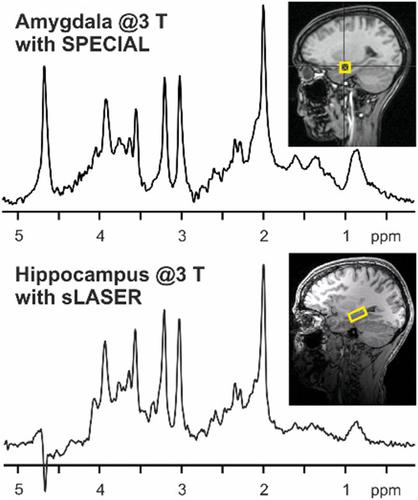当前位置:
X-MOL 学术
›
NMR Biomed.
›
论文详情
Our official English website, www.x-mol.net, welcomes your
feedback! (Note: you will need to create a separate account there.)
Advanced single voxel 1H magnetic resonance spectroscopy techniques in humans: Experts' consensus recommendations
NMR in Biomedicine ( IF 2.7 ) Pub Date : 2020-01-10 , DOI: 10.1002/nbm.4236 Gülin Öz 1 , Dinesh K Deelchand 1 , Jannie P Wijnen 2 , Vladimír Mlynárik 3 , Lijing Xin 4 , Ralf Mekle 5 , Ralph Noeske 6 , Tom W J Scheenen 7, 8 , Ivan Tkáč 1 ,
NMR in Biomedicine ( IF 2.7 ) Pub Date : 2020-01-10 , DOI: 10.1002/nbm.4236 Gülin Öz 1 , Dinesh K Deelchand 1 , Jannie P Wijnen 2 , Vladimír Mlynárik 3 , Lijing Xin 4 , Ralf Mekle 5 , Ralph Noeske 6 , Tom W J Scheenen 7, 8 , Ivan Tkáč 1 ,
Affiliation

|
Conventional proton MRS has been successfully utilized to noninvasively assess tissue biochemistry in conditions that result in large changes in metabolite levels. For more challenging applications, namely, in conditions which result in subtle metabolite changes, the limitations of vendor‐provided MRS protocols are increasingly recognized, especially when used at high fields (≥3 T) where chemical shift displacement errors, B0 and B1 inhomogeneities and limitations in the transmit B1 field become prominent. To overcome the limitations of conventional MRS protocols at 3 and 7 T, the use of advanced MRS methodology, including pulse sequences and adjustment procedures, is recommended. Specifically, the semiadiabatic LASER sequence is recommended when TE values of 25‐30 ms are acceptable, and the semiadiabatic SPECIAL sequence is suggested as an alternative when shorter TE values are critical. The magnetic field B0 homogeneity should be optimized and RF pulses should be calibrated for each voxel. Unsuppressed water signal should be acquired for eddy current correction and preferably also for metabolite quantification. Metabolite and water data should be saved in single shots to facilitate phase and frequency alignment and to exclude motion‐corrupted shots. Final averaged spectra should be evaluated for SNR, linewidth, water suppression efficiency and the presence of unwanted coherences. Spectra that do not fit predefined quality criteria should be excluded from further analysis. Commercially available tools to acquire all data in consistent anatomical locations are recommended for voxel prescriptions, in particular in longitudinal studies. To enable the larger MRS community to take advantage of these advanced methods, a list of resources for these advanced protocols on the major clinical platforms is provided. Finally, a set of recommendations are provided for vendors to enable development of advanced MRS on standard platforms, including implementation of advanced localization sequences, tools for quality assurance on the scanner, and tools for prospective volume tracking and dynamic linear shim corrections.
中文翻译:

人类先进的单体素 1H 磁共振波谱技术:专家的共识建议
传统的质子 MRS 已成功用于在导致代谢物水平发生巨大变化的条件下无创地评估组织生化。对于更具挑战性的应用,即在导致微妙代谢物变化的条件下,越来越多地认识到供应商提供的 MRS 协议的局限性,特别是在化学位移位移误差 B 0和 B 1 的高场 (≥3 T) 下使用时发射 B 1场的不均匀性和局限性变得突出。为了克服 3 T 和 7 T 下传统 MRS 协议的局限性,建议使用先进的 MRS 方法,包括脉冲序列和调整程序。具体来说,当 25-30 ms 的 T E值可以接受时,建议使用半绝热 LASER 序列;当较短的 T E值至关重要时,建议使用半绝热 SPECIAL 序列作为替代方案。应优化磁场 B 0均匀性,并应针对每个体素校准 RF 脉冲。应采集未抑制的水信号以进行涡流校正,并且最好也用于代谢物定量。代谢和水数据应保存在单次拍摄中,以促进相位和频率对齐并排除运动损坏的拍摄。应评估最终平均光谱的信噪比、线宽、水抑制效率以及是否存在不需要的相干性。不符合预定义质量标准的光谱应排除在进一步分析之外。建议使用市售工具来获取一致解剖位置的所有数据用于体素处方,特别是在纵向研究中。 为了使更大的 MRS 社区能够利用这些先进方法,我们提供了主要临床平台上这些先进协议的资源列表。最后,为供应商提供了一系列建议,以便能够在标准平台上开发先进的 MRS,包括实施先进的定位序列、扫描仪上的质量保证工具以及用于预期体积跟踪和动态线性匀场校正的工具。
更新日期:2020-01-10
中文翻译:

人类先进的单体素 1H 磁共振波谱技术:专家的共识建议
传统的质子 MRS 已成功用于在导致代谢物水平发生巨大变化的条件下无创地评估组织生化。对于更具挑战性的应用,即在导致微妙代谢物变化的条件下,越来越多地认识到供应商提供的 MRS 协议的局限性,特别是在化学位移位移误差 B 0和 B 1 的高场 (≥3 T) 下使用时发射 B 1场的不均匀性和局限性变得突出。为了克服 3 T 和 7 T 下传统 MRS 协议的局限性,建议使用先进的 MRS 方法,包括脉冲序列和调整程序。具体来说,当 25-30 ms 的 T E值可以接受时,建议使用半绝热 LASER 序列;当较短的 T E值至关重要时,建议使用半绝热 SPECIAL 序列作为替代方案。应优化磁场 B 0均匀性,并应针对每个体素校准 RF 脉冲。应采集未抑制的水信号以进行涡流校正,并且最好也用于代谢物定量。代谢和水数据应保存在单次拍摄中,以促进相位和频率对齐并排除运动损坏的拍摄。应评估最终平均光谱的信噪比、线宽、水抑制效率以及是否存在不需要的相干性。不符合预定义质量标准的光谱应排除在进一步分析之外。建议使用市售工具来获取一致解剖位置的所有数据用于体素处方,特别是在纵向研究中。 为了使更大的 MRS 社区能够利用这些先进方法,我们提供了主要临床平台上这些先进协议的资源列表。最后,为供应商提供了一系列建议,以便能够在标准平台上开发先进的 MRS,包括实施先进的定位序列、扫描仪上的质量保证工具以及用于预期体积跟踪和动态线性匀场校正的工具。











































 京公网安备 11010802027423号
京公网安备 11010802027423号